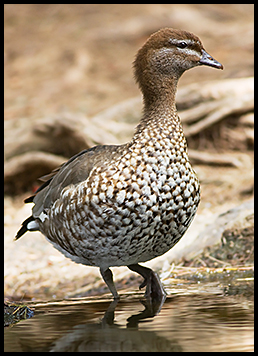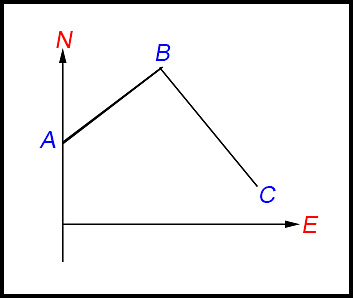Where the techniques of Maths
are explained in simple terms.
Trigonometry - Bearings and Trig. Rules.
Test Yourself 1.
- Algebra & Number
- Calculus
- Financial Maths
- Functions & Quadratics
- Geometry
- Measurement
- Networks & Graphs
- Probability & Statistics
- Trigonometry
- Maths & beyond
- Index
| Using the sine rule | 1. In a large park at the bottom of my hill, is a large recreational area with a lagoon.
From where I am standing, I notice an Australian Wood Duck about 180 m away on a bearing of 220°. I also notice a flock of similar ducks - all close to one another - about 100 m away on a bearing of 155°. |
 Source: Australian Museum. |
(i) Show that the angle through which I must move my eyes from the single Wood Duck to the flock is 65°. |
||
| 2. | ||
Three ports A, B and C are reasonably close together. Port B is on a bearing of 250° from Port A while Port C is on a bearing of 240° from Port A. Port C is 100 km east of Port B.
|
||
| CK nautical miles | ||
| Using the cosine rule. | 6. Ship A is 20 nautical miles away from Port P and is on a bearing of 55°.
|
|
7. The diagram below describes the path of a ship which leaves a Port at A on a course of 075o for 20 kilometres. When the ship reaches point B off a headland, it changes course to 130o and continues sailing for 30 kilometres to the Port at C.
(i) Show <ABC = 125o. (ii) How far, in a direct line from its starting point, is the ship when it is in Port C? (iii) What is the bearing of Port C from Port A? |
||
A Team Leader mapped out an orienteering course for the a group of beginners. She left point from B on a bearing of 050° and walked for 7 km and placed a marker N. From point N she (i) Draw a diagram to represent this information. (ii) Show that the angle BNE = 110°. (iii) What is the distance back to the base camp B from E (to the nearest 100 m)? (iv) What is the bearing of A from C (nearest degree)? Answer.(iii) BE = 12.3 km.(iv) Bearing of A from E is 268°. |
||
|
||
|
||
| Using both cosine and sine rules. | ||
| Bearings with other rules. | A ship S sails from port P on a bearing of N 60° E for 56 kms. Another ship A also leaves port P but on a bearing 110° T for 48 kms. Calculate the distance between the ships (to 1 decimal place). |
|
